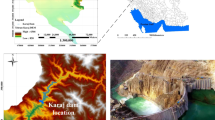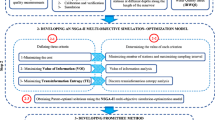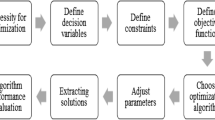Abstract
Optimal operation of multi-objective reservoirs is one of the complex and, sometimes nonlinear, issues in multi-objective hydrologic system optimization. Meta-heuristic algorithms are good optimization tools which look for decision space via simulating the behavior of animals and providing the possibility for presenting a set of points as a set of problem solutions. Therefore, in this study, developing multi-objective water cycle algorithm (MOWCA) was investigated for the optimal operation issue of Halilrood basin reservoir system (Baft, Safarood, and Jiroft Dams) in order to hydropower energy generation of Jiroft Dam, downstream demand supply (drinking, agricultural, and environmental requirements), and flood control for a period of 223 months (from October 2000 to April 2019). Also, the results of the algorithm were compared with those of the well-known non-dominated sorting genetic algorithm II (NSGA-II). To evaluate the efficiency of the used multi-objective algorithms, four performance evaluation criteria including generational distance (GD), metric of spacing (S), metric of spread (Δ), and maximum spread (MS) were used. The results of applying multi-objective performance evaluation criteria showed the superiority of the developed MOWCA method in three criteria of distance, spread, and maximum spread criteria, while the NSGA-II algorithm was superior to the MOWCA only in metric of spacing (S) criterion. Moreover, the MOWCA algorithm with total 236.07 objectives performed better than the NSGA-II algorithm with total 268.01 objectives. In Jiroft Dam’s hydropower energy generation, the MOWCA algorithm with 4278.69 MW power generation was considerably superior to the NSGA-II algorithm with 3138.55 MW MW generation during the studied period. Finally, the obtained results showed higher performance of the MOWCA algorithm than the NSGA-II algorithm in the optimal operation of Halilrood basin multi-objective reservoirs systems with different objectives.










Similar content being viewed by others
Data Availability
All data and materials generated or used during the study are available from the corresponding author by request.
References
Afshar MH, Hajiabadi R (2018) A novel parallel cellular automata algorithm for multi-objective reservoir operation optimization. Water Resour Manage 32(2):785–803
Akbarifard S, Radmanesh F (2018) Predicting sea wave height using Symbiotic Organisms Search (SOS) algorithm. Ocean Eng 167:348–356
Akbarifard S, Sharifi MR, Qaderi K, Madadi MR (2020) Optimal operation of multi-reservoir systems: comparative study of three robust metaheuristic algorithms. Water Supply. https://doi.org/10.2166/ws.2020.368
Baltar AM, Fontane DG (2008) Use of multiobjective particle swarm optimization in water resources management. J Water Resour Plan Manag 134(3):257–265
Bozorg-Haddad O, Azarnivand A, Hosseini-Moghari SM, Loáiciga HA (2017) Optimal operation of reservoir systems with the symbiotic organisms search (SOS) algorithm J. Hydroinform 19(4):507–521
Bozorg-Haddad O, Azad M, Fallah-Mehdipour E, Delpasand M, Chu X (2020) Verification of FPA and PSO algorithms for rule curve extraction and optimization of single-and multi-reservoir systems' operations considering their specific purposes. Water Supply. https://doi.org/10.2166/ws.2020.274
Chang FJ, Chen L, Chang LC (2005) Optimizing the reservoir operating rule curves by genetic algorithms. Hydrol Process 19(11):2277–2289
Coello CA (2000) An updated survey of GA-based multiobjective optimization techniques. ACM ComputSurv 32(2):109–143
Deb K (2001) Multi-objective optimization using evolutionary algorithms (Vol. 16). Wiley, Chichester
Deb K, Pratap A, Agarwal S, Meyarivan TAMT (2002) A fast and elitist multiobjective genetic algorithm: NSGA-II. IEEE Trans Evol Comput 6(2):182–197
Deep K, Singh KP, Kansal ML, Mohan C (2009) Management of multipurpose multireservoir using fuzzy interactive method. Water Resour Manage 23(14):2987
Ehteram M, Karami H, Mousavi SF, El-Shafie A, Amini Z (2017) Optimizing dam and reservoirs operation based model utilizing shark algorithm approach. Knowl-Based Syst 122:26–38
Eskandar H, Sadollah A, Bahreininejad A, Hamdi M (2012) water cycle algorithm -A novel metaheuristic optimization method for solving constrained engineering optimization problems. Comput Struct 110–111(2012):151–166
Feng ZK, Niu WJ, Cheng CT, Liao SL (2017) Hydropower system operation optimization by discrete differential dynamic programming based on orthogonal experiment design. Energy 126:720–732
Feng ZK, Niu WJ, Cheng CT, Lund JR (2018) Optimizing hydropower reservoirs operation via an orthogonal progressive optimality algorithm J. Water Resour Plan Manag 144(3):04018001
Guo X, Hu T, Wu C, Zhang T, Lv Y (2013) Multi-objective optimization of the proposed multi-reservoir operating policy using improved NSPSO. Water Resour Manage 27(7):2137–2153
Khodabakhshian A, Esmaili MR, Bornapour M (2016) Optimal coordinated design of UPFC and PSS for improving power system performance by using multi-objective water cycle algorithm. Int J Electr Power Energy Syst 83:124–133
Madadi MR, Akbarifard S, Qaderi K (2020a) Improved Moth-Swarm Algorithm to predict transient storage model parameters in natural streams. Environ Pollut 262:114258
Madadi MR, Akbarifard S, Qaderi K (2020b) Performance evaluation of improved symbiotic organism search algorithm for estimation of solute transport in rivers. Water Resour Manage 34:1453–1464
Moradi M, Sadollah A, Eskandar H, Eskandar H (2017) The application of water cycle algorithm to portfolio selection. Econ Res Ekonomskaistraživanja 30(1):1277–1298
Noori M, Othman F, Sharifi MB, Heydari M (2013) Multiobjective operation optimization of reservoirs using genetic algorithm (Case Study: Ostoor and Pirtaghi Reservoirs in Ghezel Ozan Watershed). Int Proc Chem Biol Environ Eng 51:49–54
Qaderi K, Akbarifard S, Madadi MR, Bakhtiari B (2018, August) Optimal operation of multi-reservoirs by water cycle algorithm. Water Manag 171(4):179–190
Reddy MJ, Kumar DN (2006) Optimal reservoir operation using multi-objective evolutionary algorithm. Water Resour Manage 20(6):861–878
Sadollah A, Eskandar H, Bahreininejad A, Kim JH (2015) Water cycle algorithm for solving multi-objective optimization problems. Soft Comput 19(9):2587–2603
Sadollah A, Eskandar H, Kim JH (2015) Water cycle algorithm for solving constrained multi-objective optimization problems. Appl Soft Comput 27:279–298
Schott JR (1995) Fault tolerant design using single and multicriteria genetic algorithm optimization, Doctoral dissertation, Massachusetts Institute of Technology, United States Air Force Academy
Sharifi MR, Akbarifard S, Qaderi K, Madadi MR (2021) Developing MSA algorithm by new fitness-distance-balance selection method to optimize cascade hydropower reservoirs operation. Water Resour Manag 1–22. https://doi.org/10.1007/s11269-020-02745-8
Van Veldhuizen DA, Lamont GB (1998) Multiobjective evolutionary algorithm research: a history and analysis. Technical Report TR-98–03, Department of Electrical and Computer Engineering, Graduate School of Engineering, Air Force Institute of Technology, Wright-Patterson AFB, Ohio
Wurbs RA (1993) Reservoir-system simulation and optimization models. J Water Resour Plan Manag 119(4):455–472
Xu W (2020) Study on multi-objective operation strategy for multi-reservoirs in small-scale watershed considering ecological flows. Water Resour Manage 34(15):4725–4738
Author information
Authors and Affiliations
Contributions
Hamid Reza Yavari: Data collection, Methodology, Writing.
Amir Robati: Review, Data analysis, Supervision.
Corresponding author
Ethics declarations
Consent to Participate
The authors declare their consent to participate in this work.
Consent to Publish
The authors declare their consent to publication of this manuscript by “Water Resources Management” journal.
Competing Interests
The authors declared that they have no conflicts of interest to this work.
Additional information
Publisher’s Note
Springer Nature remains neutral with regard to jurisdictional claims in published maps and institutional affiliations.
Rights and permissions
About this article
Cite this article
Yavari, H.R., Robati, A. Developing Water Cycle Algorithm for Optimal Operation in Multi-reservoirs Hydrologic System. Water Resour Manage 35, 2281–2303 (2021). https://doi.org/10.1007/s11269-021-02781-y
Received:
Accepted:
Published:
Issue Date:
DOI: https://doi.org/10.1007/s11269-021-02781-y




